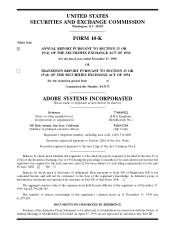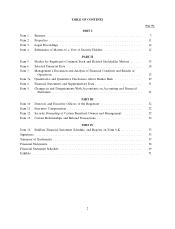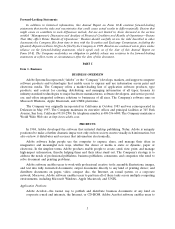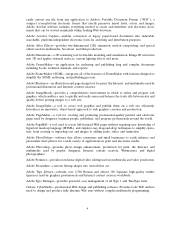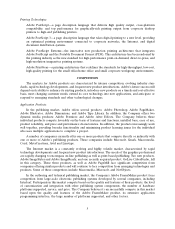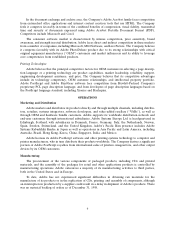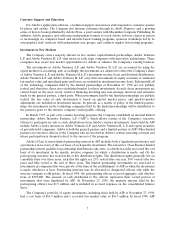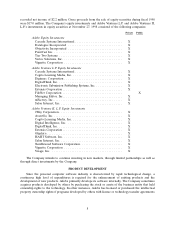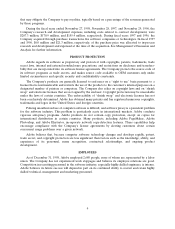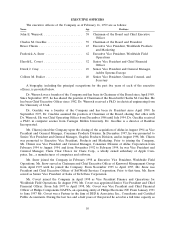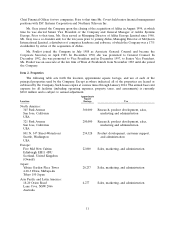Adobe 1998 Annual Report Download - page 5
Download and view the complete annual report
Please find page 5 of the 1998 Adobe annual report below. You can navigate through the pages in the report by either clicking on the pages listed below, or by using the keyword search tool below to find specific information within the annual report.Printing Technologies:
Adobe PostScript—a page description language that delivers high quality output, cross-platform
compatibility, and top performance for graphically-rich printing output from corporate desktop
printers to high-end publishing printers.
Adobe PostScript 3—a page description language that takes digital printing to a new level, providing
an optimized printing environment connected to corporate networks, the Internet, and digital
document distribution systems.
Adobe PostScript Extreme—the innovative new production printing architecture that integrates
Adobe PostScript and the Portable Document Format (PDF). This architecture has been endorsed by
the printing industry as the new standard for high-performance print-on-demand, direct-to-press, and
high-resolution imagesetter printing systems.
Adobe PrintGear—a printing architecture that redefines the standards for high-throughput, low-cost,
high-quality printing for the small office/home office and small corporate workgroup environments.
COMPETITION
The markets for Adobe products are characterized by intense competition, evolving industry stan-
dards, rapid technology developments, and frequent new product introductions. Adobe’s future success will
depend on its ability to enhance its existing products, introduce new products on a timely and cost-effective
basis, meet changing customer needs, extend its core technology into new applications, and anticipate or
respond to emerging standards and other technological changes.
Application Products:
In the publishing market, Adobe offers several products: Adobe Photoshop, Adobe PageMaker,
Adobe Illustrator, Adobe Dimensions, and Adobe Type Library. In addition, the Company offers two
dynamic media products: Adobe Premiere and Adobe After Effects. The Company believes these
individual products compete favorably on the basis of features and functions, installed base, ease of use,
product reliability, and price and performance characteristics. In addition, the products increasingly work
well together, providing broader functionality and minimizing product learning issues for the individual
who uses multiple applications to complete a project.
A number of companies currently offer one or more products that compete directly or indirectly with
one or more of Adobe’s publishing products. These companies include Microsoft, Quark, Macromedia,
Corel, MetaCreations, Avid and Linotype.
The Internet market is a constantly evolving and highly volatile market, characterized by rapid
technology developments and frequent new product introductions. The needs of the graphics professional
are rapidly changing to encompass on-line publishing as well as print-based publishing. Two new products,
Adobe ImageStyler and Adobe ImageReady, and one recently acquired product, GoLive CyberStudio, fall
in this category. These three products, as well as Adobe PageMill face significant competition from
companies offering similar products and will continue to face competition from emerging technologies and
products. Some of these competitors include Macromedia, Microsoft, and NetObjects.
In the authoring and technical publishing market, the Company’s Adobe FrameMaker product faces
competition from large-scale electronic publishing systems developed by several companies, including
Interleaf. Participants in this market compete based on the quality and features of their products, the level
of customization and integration with other publishing system components, the number of hardware
platforms supported, service, and price. The Company believes it can successfully compete in this market
based upon the quality and features of the Adobe FrameMaker product, its extensive application
programming interface, the large number of platforms supported, and other factors.
5

